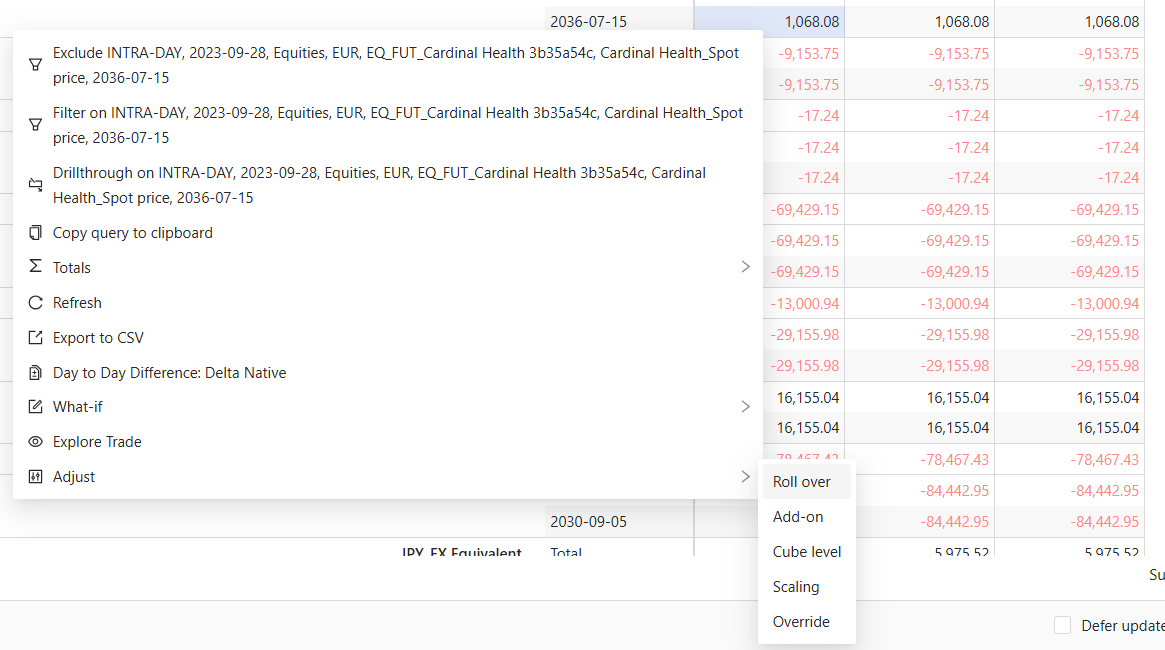Perform adjustments in the UI
This page walks you through the possible adjustment types and the process of creating and managing adjustments.
note
Atoti Sign-Off does not offer any adjustment types out of the box. These are implemented on the application server. The types described below are available in Atoti Market Risk.
Types and levels of adjustment
| Adjustment type | Description |
|---|---|
| Cube-level | Overrides a measure in the cube. No fact in the base store is added, instead, a separate store storing a representation of the location for which the override is done is used and a datastore look-up is performed to retrieve the override value. |
| Fact add-on | Offsets the current value of an entry in the base store by a specific amount. |
| Fact override | Overrides the current value of an entry with a new value. |
| Fact scaling | Modifies the data by a given factor. |
| Fact roll-over | Overrides the current data with data from a previous day. |
Valid statuses
You can perform adjustments on a task assigned to you once you have started the task, moving it to
the INITIATED status.
Create an adjustment
The task definition of your task may have a dashboard specified, where you can make adjustments to the data. To access this, in the Tasks screen, click the “Linked dashboard” button in your task’s Action row.

For details on adding a linked dashboard, see Create task definitions in the UI.
If a dashboard has not been linked, the “Linked dashboard” button is inactive. In this case, you can use any dashboard containing the relevant data.
- In your dashboard, right-click the value you want to adjust.
- In the context menu, select Adjust, then select the type of adjustment you want to perform.

- Define the various elements required, depending on the type of adjustment, then click OK:
| Field | Details |
|---|---|
| AsOfDate | roll-over only: specify the date from which you want to copy the data. |
| Currency | Cube level only. |
| Values | Cube level only: |
| Value | - Add-on: specify the value to add to the original. - Scaling: specify the value with which to multiply the original value. - Override: specify the value with which to replace the original value. |
| Reason | Select the reason from the available list. |
| Valid from and Valid to | Set a validity period. The Valid from is required, but the Valid to is optional Note: Valid from (inclusive) Valid to (exclusive). For example, 2018-09-28 to 2018-12-31 denotes a validity period from 28th Sept to 30th Dec 2018 See Recurring Adjustments |
| Comment | Enter a meaningful comment for the audit trail. |
In the pivot table, you can see the changes made. The adjustment is listed in the Tasks screen, below the task.

Recurring adjustments
To avoid having to enter the same adjustment each time, you can use the Valid from and Valid to fields to define the time period over which to apply a given adjustment.
Each time a task is initiated, any relevant recurring adjustments for that date are automatically performed.
Analysis dashboards
Atoti Sign-Off lets you view all of your adjustments for a given task in a dedicated Sign-off analysis dashboard. You can access it from the Tasks table, by clicking the “Sign-off analysis dashboard” button in the task’s Action column.
In addition, you can check out the before and after values of each individual adjustment in the Adjustment analysis dashboard. To do this, click the “Adjustment analysis dashboard” button in the Action column of the adjustment.

Delete adjustments
You may sometimes need to discard adjustments you have made, and then re-do them. For example, after a series of adjustments, you realize that the entire batch of trades was wrong or corrupted.
To discard an individual adjustment:
- In the Tasks screen table, click the x button beside the adjustment you want to discard.
- Click Yes to confirm.
The system updates the status of the adjustment to
Deleted.
By default, when you click the “Restart task” button to revert to the INITIATED status, there is an option to discard all adjustments associated with the task.
The system will still reapply any previously defined recurring adjustments, as they are considered valid.
Re-applying adjustments on failure
Adjustments that you create for a cube are stored in memory, along with all other data in the cube. This means that if the cube restarts, the adjustments will no longer exist. Atoti Sign-Off is designed to identify these server failures and, when the cube becomes available again, it will re-apply the adjustments that you had previously created.
note
Adjustments are only applied for sign-off tasks that have not yet been approved. If the task has been submitted for approval, it will need to be submitted again once the adjustments have been re-applied. Additionally, we advise checking these adjustments before approving or submitting for approval, as the data in the cube may have changed, and they may no longer be appropriate.
Cubes are polled intermittently to identify when they stop and start running. You can configure the frequency and behavior of this polling by setting specific properties.